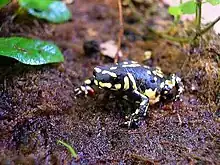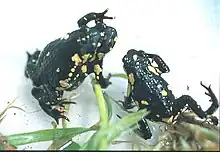| Bumblebee toad | |
|---|---|
 | |
| The name bumblebee toad comes from their distinct black and yellow pattern. | |
| Scientific classification | |
| Domain: | Eukaryota |
| Kingdom: | Animalia |
| Phylum: | Chordata |
| Class: | Amphibia |
| Order: | Anura |
| Family: | Bufonidae |
| Genus: | Melanophryniscus |
| Species: | M. stelzneri |
| Binomial name | |
| Melanophryniscus stelzneri (Weyenbergh, 1875) | |
Melanophryniscus stelzneri, commonly known as the bumblebee toad or black-and-yellow walking toad, is a species of toad in the family Bufonidae which is endemic to Argentina. It is popular in the pet trade.[1]
Description
The bumblebee toad was originally described in 1875.[2] It grows to about 2.75 cm, with females almost always being larger than males. The back of the toad is black with yellow spots and stripes. The lower ventral area is black with red markings, and the feet are typically solid red except for the hind toes. These ventral red spots can extend to the dorsum, particularly in females. Markings are highly variable and it is rare for any of them to be symmetrical.

They were first discovered in Córdoba, Argentina. Bumblebee toads are primarily found in Paraguay and Argentina, but have been occasionally observed in Uruguay and Brazil.[3] Their range may also extend into Bolivia.[4]
Diet
The bumblebee toad's natural diet is made up of insects and worms. Melanphryniscus sp. are toxic in the wild. It is believed that these toxins are created from alkaloids found in their natural diet.[5] The brightly colored pattern of bumblebee toads is an example of aposematism. In captivity, bumblebee toads are non-toxic.
References
- 1 2 Esteban Lavilla, Diego Baldo, Lily Rodríguez (2004). "Melanophryniscus stelzneri". IUCN Red List of Threatened Species. 2004: e.T54831A11212370. doi:10.2305/IUCN.UK.2004.RLTS.T54831A11212370.en. Retrieved 17 November 2021.
{{cite journal}}: CS1 maint: multiple names: authors list (link) - ↑ Weyenbergh (1875). "Apuntes Pequenos". Periodico-Zoológico (in Spanish and German). Buenos Aires. 1 (4): 331–333. Archived from the original on 6 July 2022 – via Google Books.
- ↑ Orrell, Thomas; Informatics Office (2022). "NMNH Extant Specimen Records (USNM, US)". National Museum of Natural History, Smithsonian Institution. doi:10.15468/hnhrg3.
{{cite journal}}: Cite journal requires|journal=(help) - ↑ De la Riva, Ignacio; Kohler, Jorn; Lotters, Stefan; Reichle, Steffen (2000). "Ten years of research on Bolivian amphibians: Updated checklist, distribution, taxonomic problems, literature and iconography". Revista Espanola de Herpetologia. 14: 19–164 – via ResearchGate.
- ↑ Hantak, Maggie M.; Grant, Taran; Reinsch, Sherri; Mcginnity, Dale; Loring, Marjorie; Toyooka, Naoki; Saporito, Ralph (2013). "Dietary Alkaloid Sequestration in a Poison Frog: An Experimental Test of Alkaloid Uptake in Melanophryniscus stelzneri (Bufonidae)". Journal of Chemical Ecology. 39 (11–12): 1400–1406. doi:10.1007/s10886-013-0361-5. PMID 24190023. S2CID 533559 – via Springer Link.
